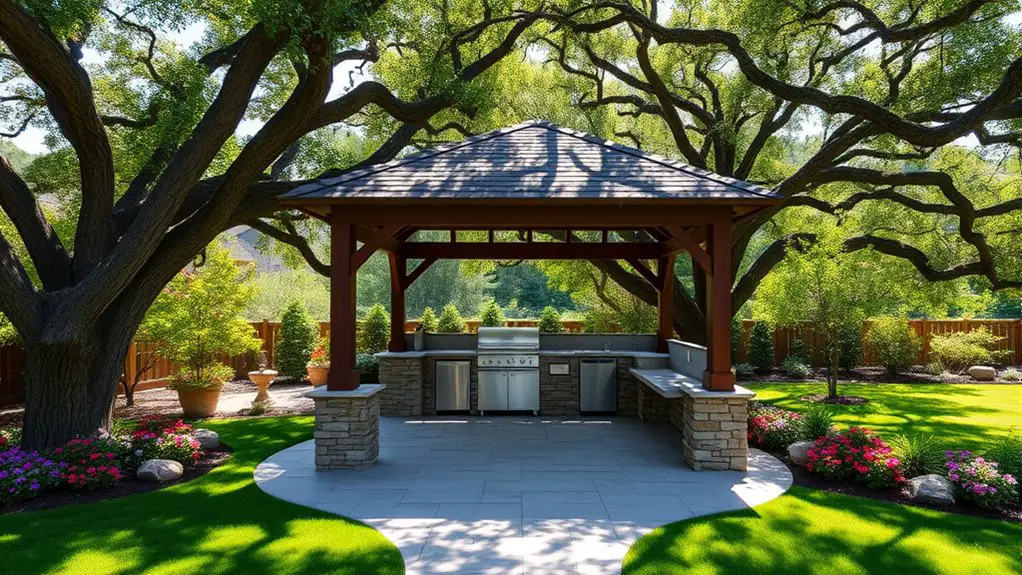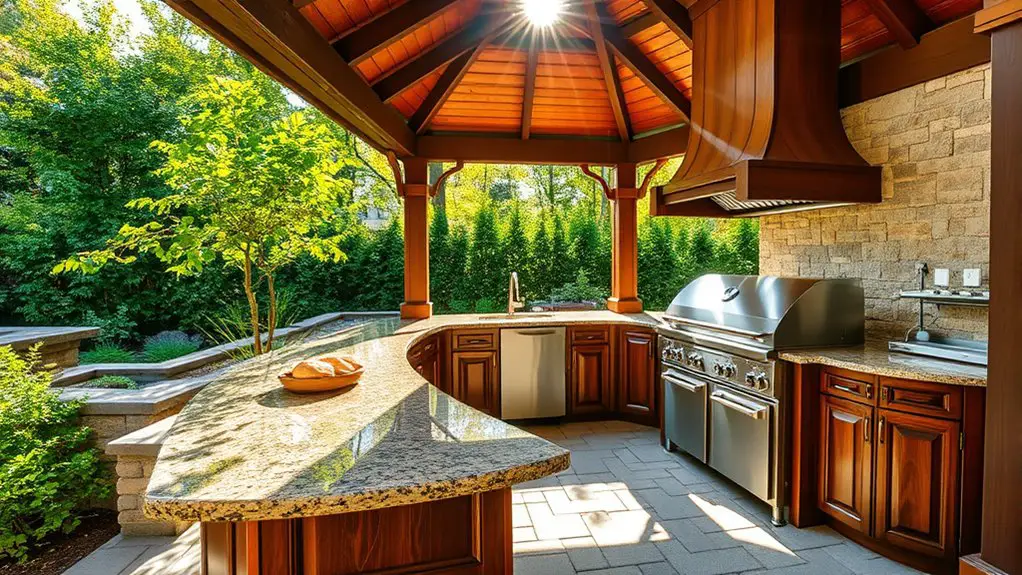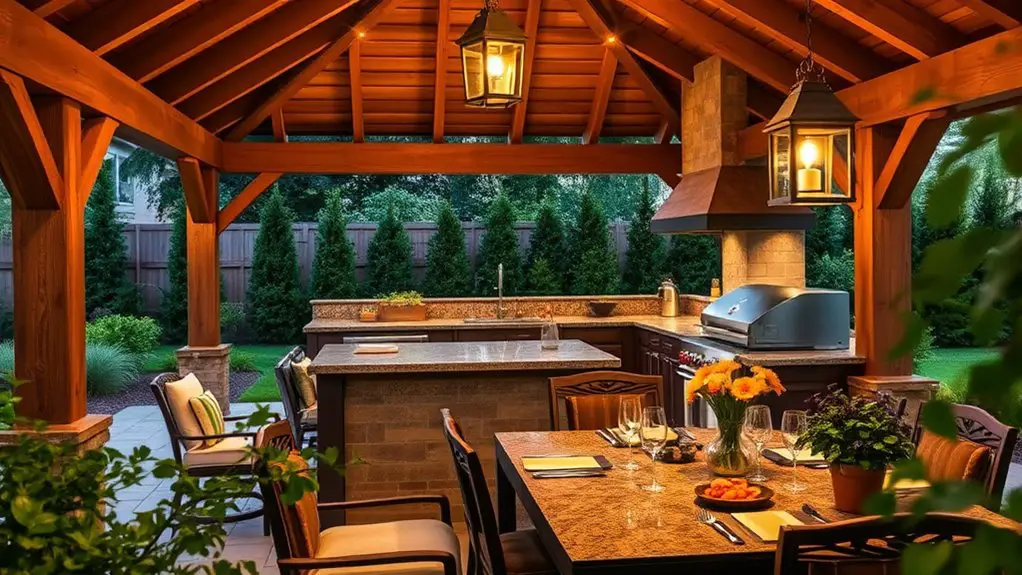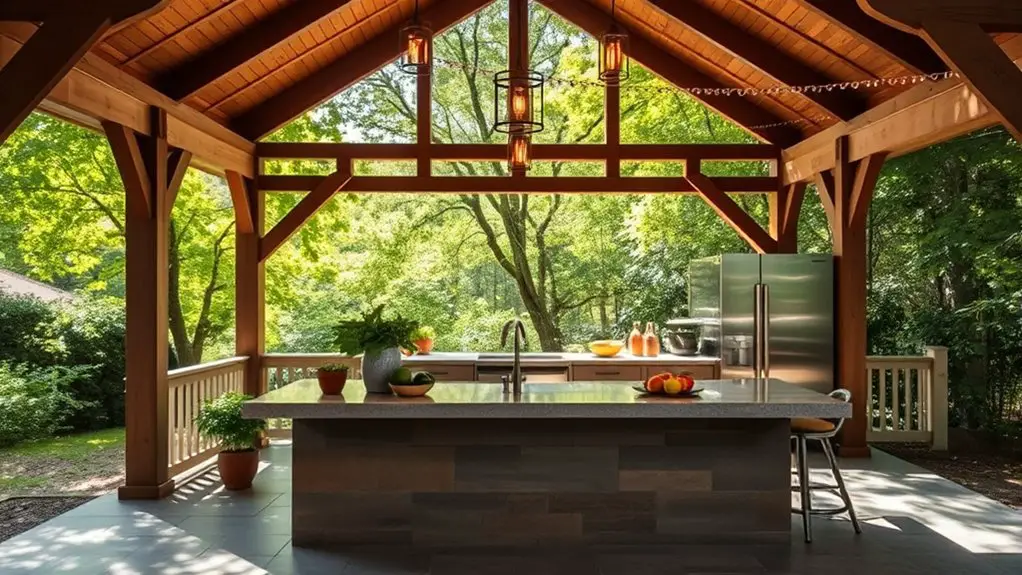To build an outdoor kitchen in your gazebo, start by choosing the right location that captures natural light and complements your outdoor space. Design a functional layout, ensuring easy access between the grill, prep area, and sink. Select durable, weather-resistant materials for countertops and cabinets. Incorporate essential appliances and create comfortable seating for guests. Finally, don’t forget about safety measures and maintenance routines. Keep exploring to uncover tips on enhancing ambiance and functionality for your new outdoor culinary haven.
Choosing the Right Location for Your Gazebo

When you’re deciding where to place your gazebo, have you considered how it will interact with your outdoor kitchen? The right location factors can enhance both aesthetics and functionality. Think about your gazebo orientation; positioning it to capture natural light can create a warm, inviting atmosphere.
Consider wind patterns and sun exposure, ensuring the gazebo provides shade during peak hours while maintaining visibility of your cooking area. A well-placed gazebo can act as a natural extension of your kitchen, offering a seamless flow for entertaining guests. Additionally, taking into account sun and shade exposure is crucial for creating a comfortable outdoor environment.
Sustainable practices play an important role, too. Using eco-friendly materials and considering local flora can create harmony within your space. Remember, the goal is to enjoy the freedom of outdoor living, so choose a location that complements your lifestyle while promoting relaxation and connection. By thoughtfully selecting your gazebo’s site, you’ll enhance both your outdoor kitchen experience and your overall enjoyment of the space.
Designing Your Outdoor Kitchen Layout
After you’ve determined the ideal location for your gazebo, it’s time to focus on how to design your outdoor kitchen layout. Start by considering the key layout considerations: the placement of your grill, prep area, and sink. Aim for a triangular design to enhance flow efficiency, allowing you to move seamlessly between cooking, prepping, and cleaning.
Position your grill near the entrance for easy access while keeping the prep area close to the sink for convenience. Think about incorporating sustainable materials that blend with your environment, fostering a natural feel. Don’t forget about adding ample counter space for food prep and serving; flexibility is key to creating a welcoming atmosphere. Additionally, ensure you have adequate ventilation to prevent carbon monoxide buildup, which is crucial for safety when cooking outdoors.
Finally, consider incorporating storage solutions to keep utensils and ingredients within reach, ensuring your outdoor kitchen isn’t just functional, but also a liberating space for culinary creativity.
Selecting Materials for Durability and Aesthetics

While selecting materials for your outdoor kitchen, it’s essential to strike a balance between durability and aesthetics to guarantee your space not only withstands the elements but also complements your landscape. Opt for weather-resistant materials that offer longevity while providing the aesthetic appeal you desire. Contemplate using stainless steel for appliances, and stone or composite for countertops. Additionally, consider incorporating materials like polycarbonate roofs to enhance protection against the elements while maintaining a modern aesthetic.
Here’s a quick overview of materials to contemplate:
| Material | Benefits |
|---|---|
| Stainless Steel | Corrosion-resistant, sleek look |
| Natural Stone | Unique textures, durable |
| Composite Decking | Low maintenance, eco-friendly |
| Teak Wood | Water-resistant, classic style |
Essential Appliances and Equipment for Outdoor Cooking
Choosing the right materials sets the stage for incorporating the right appliances and equipment in your outdoor kitchen. Embracing the freedom of outdoor cooking means selecting versatile and sustainable appliances that enhance your culinary experience. Here are essential items to evaluate:
- Grill Types: Opt for gas, charcoal, or electric grills based on your cooking style and flavor preferences.
- Cooking Surfaces: Incorporate durable countertops made from materials like stainless steel or stone for easy maintenance and resilience.
- Storage Solutions: Invest in weather-resistant cabinets and shelving to keep your utensils and ingredients organized and accessible. Additionally, ensure the grill is positioned safely within the gazebo to reduce fire hazards while cooking.
Incorporating Seating and Dining Areas

When designing your outdoor kitchen, it’s essential to think about seating and dining areas that enhance both comfort and functionality. You’ll want to choose seating options that invite relaxation while considering how to layout your dining space for easy flow and accessibility. To complete the experience, integrating sustainable lighting solutions can elevate the ambiance, making your outdoor gatherings memorable.
Choosing Comfortable Seating Options
As you design your outdoor kitchen, it’s essential to prioritize comfortable seating options that enhance both relaxation and dining experiences. Look for versatile furniture that complements your space while providing ample comfort. Incorporating comfortable cushions into your seating will invite guests to linger longer as they enjoy your culinary creations.
Consider these options for your seating area:
- Lounge chairs: Perfect for relaxation, they offer support and comfort.
- Dining benches: Space-efficient and casual, they encourage social interaction.
- Bar stools: Great for elevated countertops, they create a lively atmosphere.
Designing Dining Layouts
Creating a well-thought-out dining layout is key to maximizing the functionality of your outdoor kitchen. By understanding various dining styles and optimizing your layout, you can create a space that encourages connection and relaxation. Consider the flow of movement and the placement of seating and tables to guarantee comfort and accessibility.
Here’s a simple table to help visualize your options:
| Dining Style | Layout Optimization |
|---|---|
| Casual Gatherings | Use flexible seating options |
| Formal Dining | Central table for focus |
| Buffet Style | Linear layout for ease |
| Lounge Setting | Cluster seating areas |
Enhancing Ambiance With Lighting
To truly elevate your outdoor kitchen experience, contemplate how lighting can transform your seating and dining areas into inviting spaces for gatherings. Ambient lighting not only enhances mood but creates an enchanting atmosphere where memories are made. Here are some sustainable lighting options to contemplate:
- String Lights: Hang energy-efficient LED string lights to create a warm, inviting glow.
- Solar Lanterns: Position solar-powered lanterns around your dining area for eco-friendly illumination.
- Pathway Lights: Use low-voltage pathway lights to guide guests while adding a touch of elegance.
Adding Finishing Touches and Decor
Finishing touches and decor can elevate your outdoor kitchen from functional to fabulous, enhancing both its aesthetic appeal and your cooking experience. Start by incorporating decorative elements like eco-friendly planters filled with herbs or vibrant flowers. These not only beautify the space but also provide fresh ingredients at your fingertips.
Consider adding personal touches such as custom signage or handmade utensils that reflect your style and personality. Sustainable materials, like reclaimed wood or recycled metal, can further emphasize your commitment to the environment while adding unique character.
Don’t overlook textiles; weather-resistant cushions or tablecloths can introduce color and comfort, inviting you and your guests to linger. Finally, a few strategically placed candles or lanterns can enhance the ambiance for evening gatherings, making your outdoor kitchen a true extension of your home. Embrace creativity and freedom in your design, and enjoy a space that inspires culinary adventures.
Ensuring Proper Safety and Maintenance
While enjoying your outdoor kitchen can be a delightful experience, ensuring proper safety and maintenance is essential for a worry-free cooking environment. Start by implementing fire safety measures to prevent accidents. Keep a fire extinguisher nearby and routinely check your grill for gas leaks or wear. Additionally, ensure that your gazebo is securely anchored to withstand strong winds, as securing gazebos with anchors is crucial for safety.
Next, consider pest control to protect your space. Regularly clean your kitchen area to avoid attracting unwanted critters. Here are a few tips to keep your outdoor kitchen safe and functional:
- Inspect appliances regularly for any signs of wear or damage.
- Store food securely in sealed containers to deter pests.
- Clean surfaces and grills after each use to maintain hygiene and prevent infestations.
Frequently Asked Questions
What Permits Are Needed for Building an Outdoor Kitchen in a Gazebo?
When planning your outdoor kitchen, check local regulations and building codes. You’ll need permits for construction, electrical, and plumbing work. Ensuring compliance not only protects your investment but also embraces sustainable building practices for your freedom.
How Do I Prevent Pests in My Outdoor Kitchen Area?
To prevent pests in your outdoor kitchen area, consider employing pest control methods alongside natural repellents. Regularly clean surfaces, seal food containers, and utilize plants like mint or lavender to repel unwanted critters sustainably.
Can I Install a Sink in the Gazebo Kitchen?
Absolutely, you can install a sink in your gazebo kitchen! Just consider plumbing considerations like drainage and water supply. With proper sink installation, you’ll create a functional space that enhances your outdoor cooking experience.
What Is the Best Way to Protect Appliances From Weather Damage?
Ever wonder how you can keep your appliances safe from the elements? Using appliance covers and weather resistant materials is key. Think of it as giving your outdoor kitchen a cozy, protective blanket against nature’s whims.
How Do I Ensure Proper Drainage in My Outdoor Kitchen?
To guarantee proper drainage in your outdoor kitchen, consider innovative drainage solutions like sloped surfaces and strategically placed drains to manage water runoff effectively. This keeps your space functional and sustainable, maintaining its charm during any weather.

